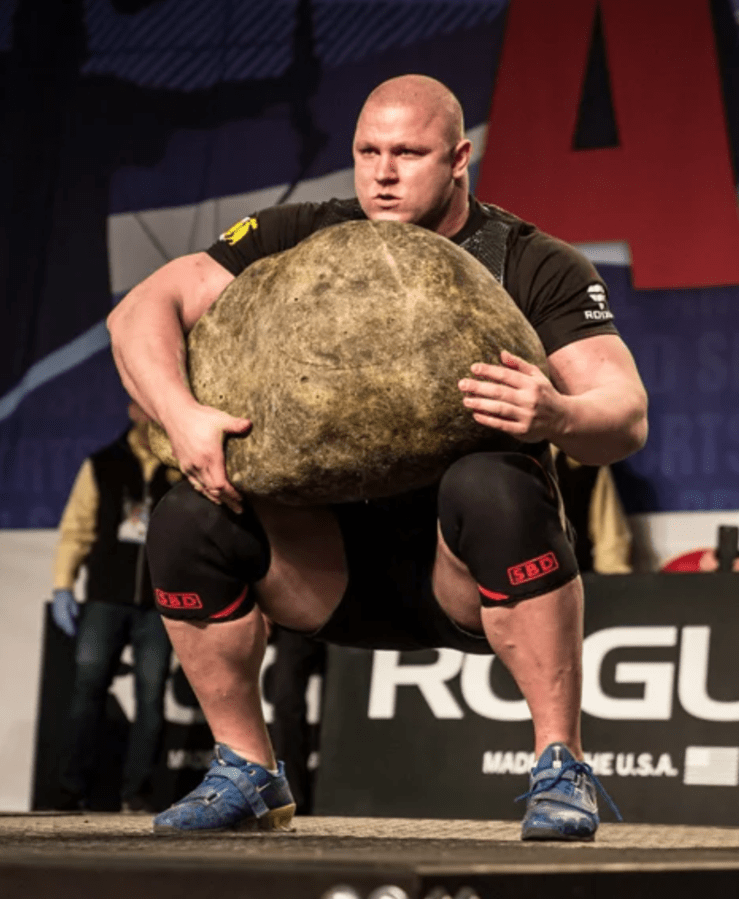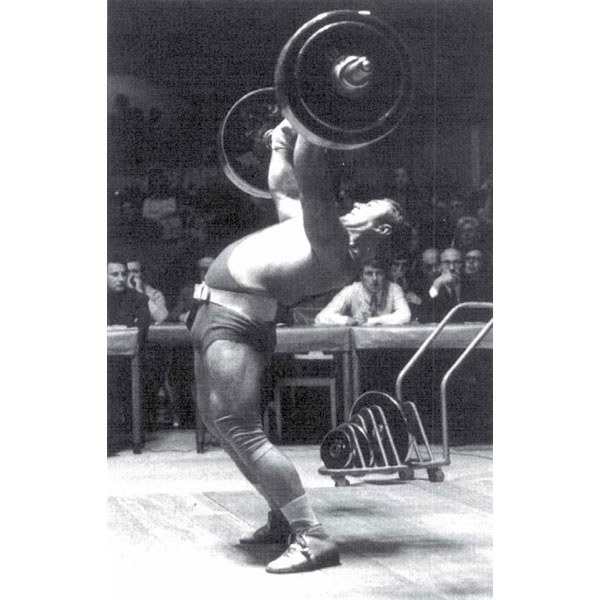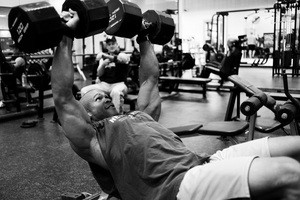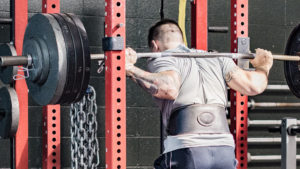How to Start Strongman Training
The clue is in the name – the strongest people on planet earth, are strongmen. While there are strength sports that specialize in different disciplines such as powerlifting in static strength and weightlifters for explosive power – nothing comes close to being able to pull a plane, walk with 700kg crushing your spine or break deadlift world records. If you’ve ever wanted to start strongman training – look no further for the most comprehensive article series you’ll find on the web.
The Giants of the Strongman World may belong to a realm of their own compared to us mere mortals – but fortunately, their training methods don’t.
Personal Experience
As a strongman myself, I may carry a little bias with this method of training – but rest assured, I’ve experienced pretty much every single training method going up until now.
From running marathons to bodybuilding, from early stage rehab to Olympic weightlifting – and then a longer stint in the world of powerlifting – I can safely say – the principles taken from strongman training represent a philosophy…a way of life and virtue that I hold close to my heart –
Anti-fragility.
JTS System - Become Anti Fragile
Join our JTS System for the next step in your training.
What it Means to Be Anti Fragile…
Anti-Fragility – where the quality of something improves when exposed to external, often chaotic stressors.
Now this isn’t to criticize any other strength athlete – the notion of getting strong by its very nature cultivates anti-fragility in one way or another. But the concept of specialization often pulls you towards a fragile world.
Let’s use an example.
A powerlifter is really strong. Like, really strong. When they have their monolift, Eleiko Calibrated Plates, spotters to hand and all the supportive gear they like.
But what happens when they go to a gym, with a whole host of different variables?
Better yet, what happens when they need to carry things? Do DIY around the house? Jump start their car?
Being one-dimensional leaves cracks in your game – a chink in your armor – a weak link.
The whole concept of strongman is to remove all of these weaknesses and make you, all round – a stronger human being.
Are you ready?
Time to show you exactly how to start strongman training.
What is Strongman Training?
In a nutshell – strongman training, when done correctly, serves to improve all facets of strength and remove all weaknesses.
The sport we’ve come to know and love that floods our TVs at Christmas time can be broken down into 3 primary areas:
- Static Events: Deadlift, Viking Press etc.
- Dynamic Events: Yoke, Farmers, Loaded Carries etc.
- Triple Extension / Squatting: Log Press, Atlas Stones, Throwing etc.
From here we have the two main variables that govern all forms of strength and strongman training:
The Skill (e.g. stones vs. farmers)
The Output (e.g. reps vs. max)
Type of Strength + Dominant Energy System
Both of which are directly influenced by the training variables you implement (e.g. loading, frequency, training volume etc.)
Kinematics (A.K.A Technique)
What technique is needed to optimize your performance and achieve technical mastery.
Physiological Demand
What bodily systems are placed under stress during strongman training and how to effectively train them.
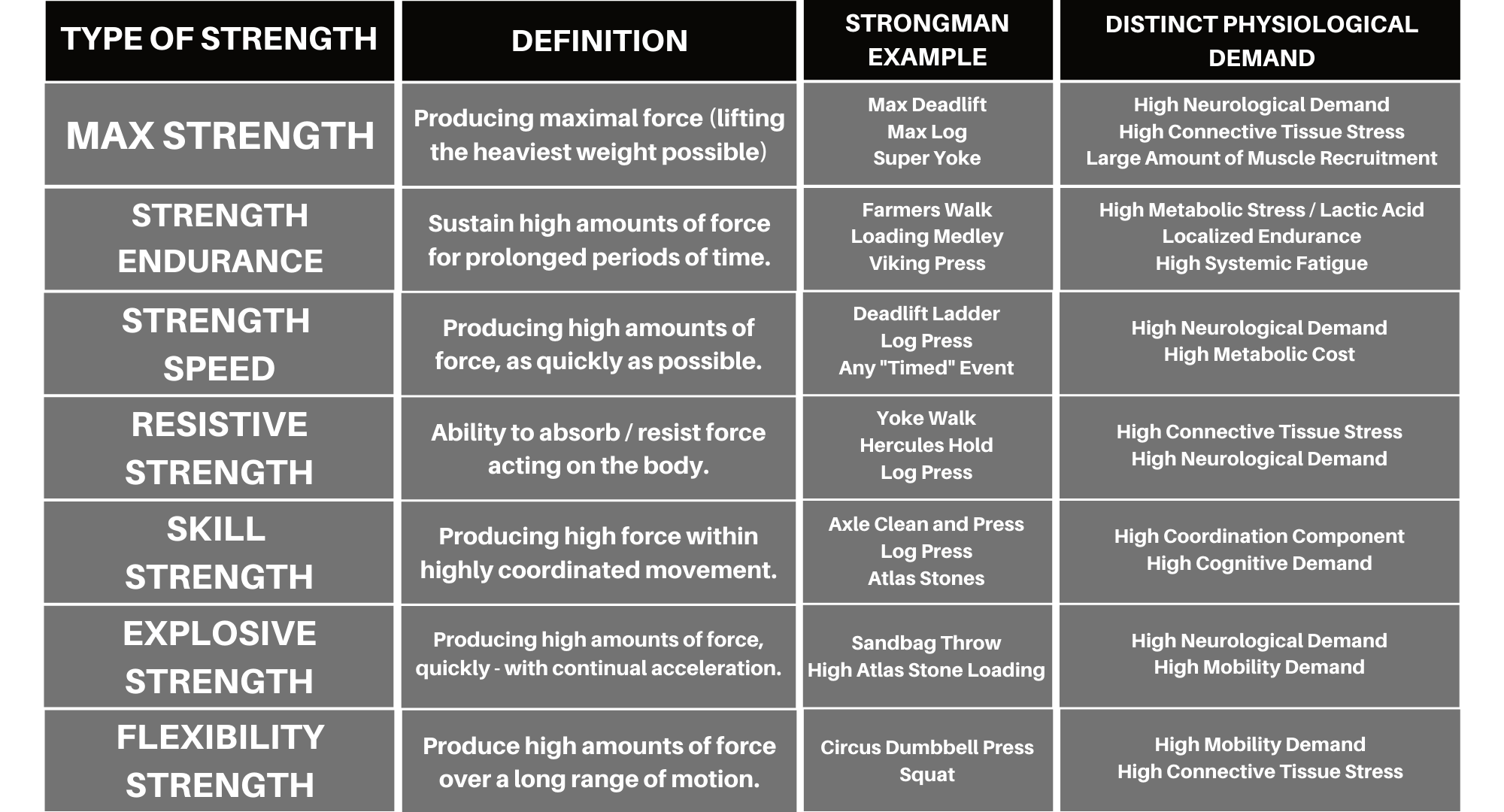
Skill in Strongman Training
This is where we’re going to split this guide in two.
Today’s article is going to cover the “skill” aspect of strongman training.
We’re going to give a general, overview of what comprises “efficient technique” for the majority of people getting into strongman training.
Note – this might not be the perfect setup for you as an individual – but it’s the perfect point to work towards.
You can also stay tuned for part 2 – including all the reps, sets and a free program.
Now – let’s cover what events are actually involved in strongman training.
Static Events: Deadlift
The king of all exercises. The deadlift is a staple in strongman and although it may only be tested in one event in competition – it’s affect on posterior chain strength is unparalleled.
Not only does it provide immense overload to your hamstrings, glutes and erector spinae when compared to other movements (Camara et al., 2016), but it also does a phenomenal job of improving your rate of force development (Swinton et al., 2011), which is a key factor in the performance of almost any athletic task (Aagaard et al., 2002).
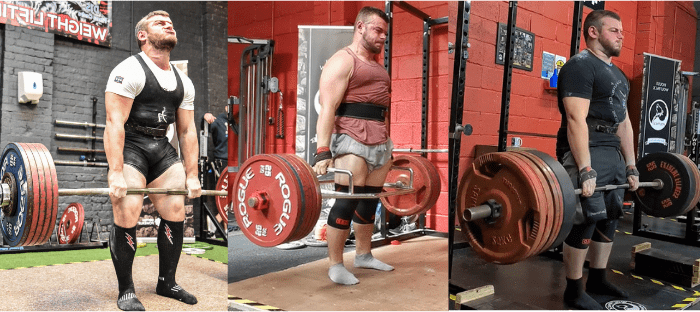
Within strongman, the techniques employed are centered around the conventional deadlift (as opposed to sumo – insert hyperlink here) – but with different equipment and often varying heights.
Technique
Stance
Your feet should be positioned somewhere between your shoulder and hip-width.
The goal should be to align structure and function to maximize your biomechanical support.
Anthropometric differences such as body mass, limb length, etc. play a huge role in what would be deemed “optimal”.
Bigger, Heavier Lifters tend to have naturally wider hips – meaning your foot position will (at least on the outside), look very wide – although it still tends to fall within the shoulder to hip-width range.
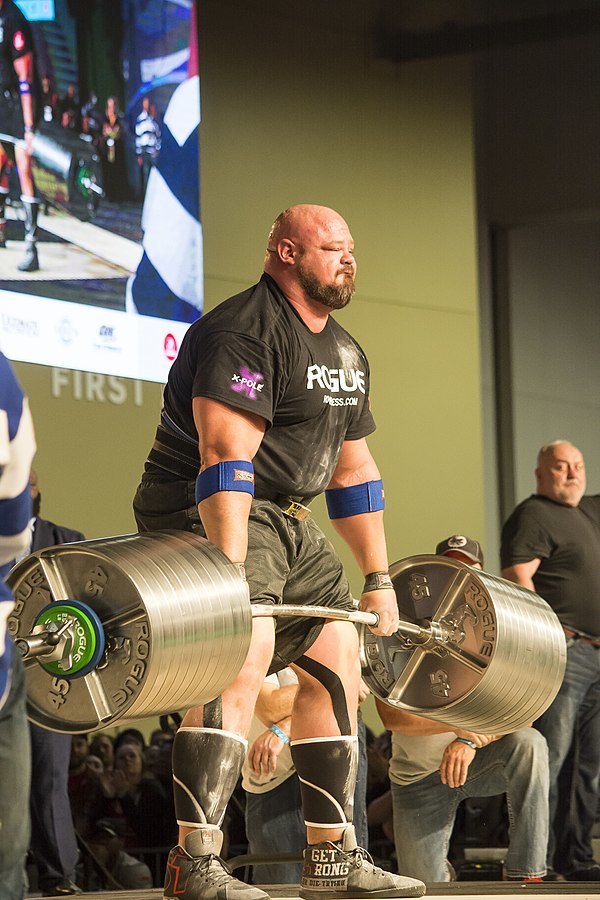
The Giant - Brian Shaw weighing in at 400lb+ is known for having a relatively wide stance in the deadlift.
And alternatively, if you’re a smaller framed lifter, you will probably be best adopting a much narrower position (often narrower than you think).
Grip
Double Overhand or Straps. Now depending on how familiar you are with the lifting world, you may or may not be aware that there are primarily, 5 types of grip.
- Double Overhand
- Straps
- Mixed
- Hook
- ‘Monkey’ / Thumbless
All are useful, in different situations. Mixed grip has shown to predispose people to a greater risk of bicep injury (Beggs, 2011), so as a general rule, this tends to be avoided (particularly in strongman).
The thumbless grip is only really necessary for an axle, due to the thicker barbell being very difficult to hold – but can be a great way to train grip strength.
Hook grip is far too painful for most.
Double overhand is, arguably the best grip of all for safety and ensuring control – but it’s unfortunately, the weakest.
Leaving the final setup – straps.
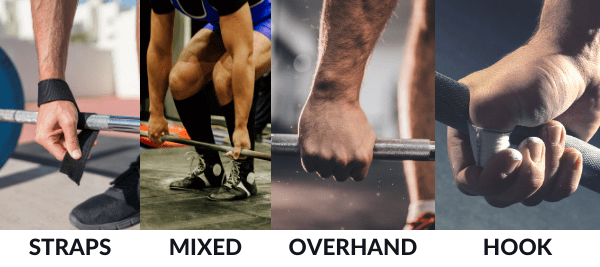
If you’re new to lifting, then utilising a double overhand grip will also help to control the load you’re lifting, as well as building grip strength. Over time, you can gradually transition to one of the other types of grip mentioned above. And eventually, your deadlift strength will outpace your grip strength – in which case, straps are used (and necessary) to get the most out of the movement.
Aim / Execution
Bar path should be vertical / slightly inward toward the lifter.
You’re aiming to position your hips as close to the barbell as physically possible, in order to reduce the length of the moment arm and the torque required.
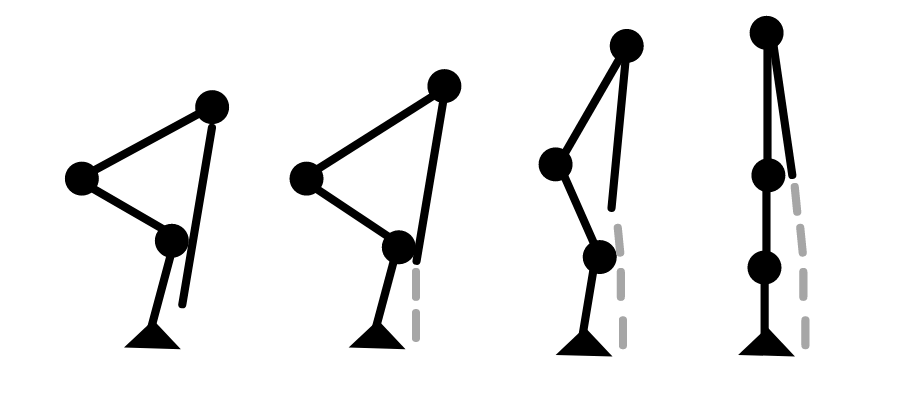
Technical Tips – Deadlift
Stand Back
Try standing an inch or so further back and learning to “pull your shins to the bar” at the start of the lift. This helps to initiate leg drive and keeps the bar closer to the body throughout the lift.
Lats
The Lats stabilize the spine, not the shoulder. You might hear this cue often in the world of deadlifting – to focus on “pulling the bar in”. The bar doesn’t randomly move forward and backwards unless you move in a way to cause it to move. So, if you’re using your lats to “pull the bar in” – you’re too far over the bar and pushing it away from you during the lift.
Head Position
Learn to use your head. It influences your center of mass quite a bit. This one is so incredibly individual I won’t provide specific recommendations – but either way – learn to use it during the lift. Super tip – the bigger your head, the greater the influence it has. Genuinely true.
**NOTE – You will notice I didn’t mention a neutral spine as a key component of deadlift execution. Rather than discussing it at length in this article – stay tuned for an upcoming article discussing this topic in depth!
Static Events: Pressing
The overhead pressing is a staple within strongman training. The goal is to put a weight overhead, recruiting the deltoids, triceps, an immense amount of core activation (McGill et al., 2009).
Depending on which variation you do, overhead exercises are a great way of training lower body power, showing similar benefits to that of jump squat training (Lake et al., 2014).
In strongman training, overhead pressing is typically done with an axle, log or circus dumbbell.
Technique
Which Type?
Pressing can be subdivided into 4 main methods:
- Strict Pressing
- Push Press
- Push Jerk
- Split Jerk
The first involves the exclusive use of the shoulders. The other 3 involve increasing amounts of “leg drive” to complete the lift – drastically changing the technique you’ll use.
Each variation will depend on one primary variable – your skill.
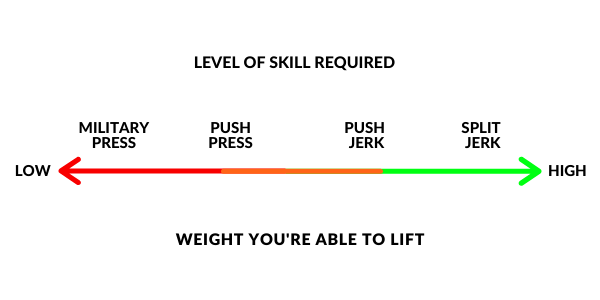
Grip
Strict Press – a great starting point is for your forearm to be perpendicular to the floor, when you’re half way through the press.
If your wrist is on the inside of your elbow, you’re placing a huge demand on the triceps (which is great, if you have strong triceps) – and any wider, you’re placing a huge demand on rotator cuff strength (recipe for disaster for most people).
Aim / Execution
Ever been near trees on a windy day? Notice how the taller ones sway much more compared to a smaller one?
It’s simple physics.
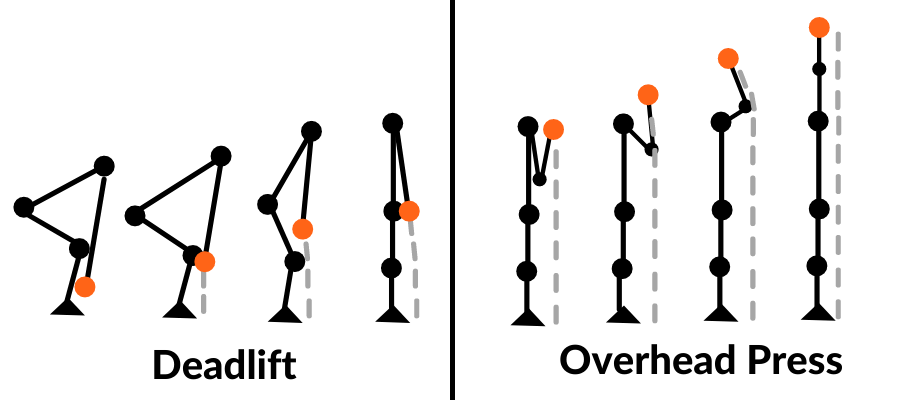
When you compare the deadlift (when the weight is much lower to the ground) versus an overhead event (where the weight is as high as it physically can be) – it becomes obvious that the demand for balance and stability on the overall system is much greater.
Your execution should be centered around two things:
1. Stacking
Ideally, you will have the weight directly above your shoulders, above your hips, your knees and ankles. This gives the greatest amount of “biomechanical support”.
2. Midline
Similar to the above, you want the line of force (the bar) to be central over the base of support (the midline of the foot).
When strict pressing – there will inevitably be a slight degree of hyperextension or torso “lean”.
Provided you maintain tension through your glutes, quads and abs – this is safe to do so when you’ve gradually exposed your body to those positions.
Although I wouldn’t recommend the extreme positions they used to adopt back when the “strict press” was an Olympic event – I don’t think I’ve ever seen a heavy strict press done without some torso inclination.
With the other 3 variations however – this isn’t necessary or even feasible. The goal should be to maximize leg drive.
The most simplified way to learn the “dip” is to remember 2 things:
- The weight should stay in line with your hip joint at all times.
- Don’t let your elbows drop (or fall behind your wrists)
From there, you effectively perform a ¼ squat and rapidly triple extend through the hip, knee and ankle, aiming to throw the weight as high as possible – finishing with the press from the upper body (Bishop et al., 2018).
Technical Tips – Pressing
Slow / Shorten the Dip
Because the legs are involved, novices have a tendency to over-rely on the range of motion they have to generate power. Focus on generating the power over a much shorter distance than you think. It also helps carry over for when you get on a log – where the mechanics of the lift physically won’t allow you to dip low.
Pause in the Dip
To help reinforce stability, I always recommend an isometric hold in the bottom portion of the dip, before you extend. Trust me – it will revolutionize your overhead strength.
Dynamic Events: Loaded Carries
I’ve spoken about the benefits of loaded carries before, but to reiterate – loaded carries in strongman training, truly build your hips like nothing else.
Whether it’s a front carry (with a sandbag/keg) to build strength endurance and tax your upper back (Zemke et al., 2011), or a yoke walk strengthening your glute med/QL Co-Contraction (McGill et al., 2009) – your midline stability and overall body strength as a result, will go through the roof.
Technique
Which Type?
In strongman training, there are 3 distinct “loaded carries” performed:
Yoke
Farmers Walk / Frame
Front Loaded Carries
Aim / Execution – Yoke
Simple in theory – difficult in execution. The frame of the yoke should sit across your shoulders so that it aligns the weight over your hips / the midline of your foot and provides the greatest biomechanical support.
We want the hips under the shoulders at all times.
This means – we keep the torso completely fixed in position – generating stiffness throughout your back and core.
And you move / walk from the hip – restricting how much your knees bend as you walk.
Simple.
Technical Tips – Yoke
Endurance and Speed before Strength
The yoke is a very demanding exercise. Fortunately, speed training is a staple of improving yoke performance. Aiming to achieve a pace of 2m/s is a common goal within strongman training (i.e. you should be covering 20m in 10 seconds or less).
On the other hand, doing longer runs as well (particularly as a novice / intermediate) helps to reinforce good mechanics and prevent “cheating” or compensations we see when people only ever train quick (e.g. torso rotation, over striding etc.)
Aim / Execution – Farmers
Grip. Grip. Grip.
The greatest difficulty of this exercise is by far the grip demand. You need to be able to physically hold onto the implement before you move it.
Now, once you reach a certain level of grip strength – speed becomes the next goal – but for most people reading this article, you will need a strong grip.
Similar to the yoke, just a different load position.
You want to keep it as close to the hip joint as possible, using short, frequent strides to complete the run.
Due to the farmers not creating axial compression (i.e. on top of your spine), you can actually position your shoulders slightly in front of the weight to help carry you forward.
Technical Tips – Farmers
A Fast Position
Due to the farmers not creating axial compression (i.e. on top of your spine), you can actually position your shoulders slightly in front of the weight to help carry you forward.
Middle of the Handle
When you become advanced, you can start to adjust grip position to “tilt” the weight. But as a general rule, you want to place your hand directly in the middle of the handle, so you have complete control of your grip. Then position your body in a means to increase speed.
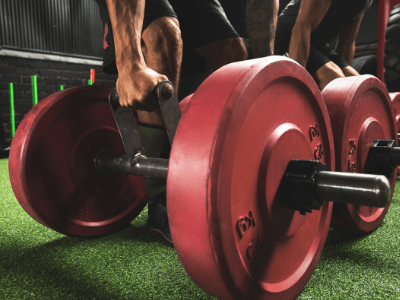
Triple Extension / Squatting
Technically two different movements – but similar enough in strongman to bundle together.
Triple extension refers to the coordinated, explosive effort of the hip, knee and ankle (DeWeese et al., 2012). This is typically done over a shorter range of motion (i.e. the dip and drive within a push press).
Think of it as “condensing the energy of a squat” into the upper 3rd range of the movement.
Where as a squat, as we know, involves loading the hip, knee and ankle through a deeper range of motion – and is often heralded as the king of all lower body exercises (Russell et al., 1989).
These two are of vital importance because, with the possible exception of loaded carries, almost all exercises in strongman training require a strong (and powerful) pair of legs.
Whether it’s the actual squat being tested…or whether it’s the use of the legs in something like an atlas stone load – you need to get used to driving with the legs and hips.
Technical Tips – Triple Extension
Get on your Toes
Most gym goers have no problem extending the hip and knee, but then really struggle (and often forget) to use one of the strongest joints in the human body (the ankle).
Keep the Load Close to your Body
Get on your toes and pull the weight as high as possible. This works for any and all events that require triple extension.
If you focus on keeping the weight as close to your midline as possible, all the force you apply into the implement with be vertical – maximising the height you can move the weight to.

Technical Tips – Squat
Control the Descent
You earn the right to move explosively. Due to the longer range of motion, there’s an inherent decrease in joint stability. Learn how to control the lowering portion of any squatting motion before you start to think about moving quick.
Mid Foot
Irrespective of whether it’s a stone, a keg, or a bar – the “squatting pattern” requires that the weight of the system (i.e. you and the implement) is centered over the midline of the foot.
So there you have it – the SKILL required for each strongman event and a great starting point for each.
Now, the next big question…what if I don’t have access to the equipment?
This is where part 2 comes in – so stay tuned…
Reference List
Aagaard, P., Simonsen, E. B., Andersen, J. L., Magnusson, P., & Dyhre-Poulsen, P. (2002). Increased rate of force development and neural drive of human skeletal muscle following resistance training. Journal of applied physiology, 93(4), 1318-1326
Beggs, L. A. (2011). Comparison of muscle activation and kinematics during the deadlift using a double‐pronated and overhand/underhand grip.
Bishop, C., Chavda, S., & Turner, A. (2018). Exercise technique: the push press. Strength & Conditioning Journal, 40(3), 104-108.
Camara, K. D., Coburn, J. W., Dunnick, D. D., Brown, L. E., Galpin, A. J., & Costa, P. B. (2016). An examination of muscle activation and power characteristics while performing the deadlift exercise with straight and hexagonal barbells. The Journal of Strength & Conditioning Research, 30(5), 1183-1188
DeWeese, B. H., Serrano, A. J., Scruggs, S. K., & Sams, M. L. (2012). The clean pull and snatch pull: proper technique for weightlifting movement derivatives. Strength & Conditioning Journal, 34(6), 82-86
Lake, J. P., Mundy, P. D., & Comfort, P. (2014). Power and impulse applied during push press exercise. The Journal of Strength & Conditioning Research, 28(9), 2552-2559
McGill, S. M., McDermott, A., & Fenwick, C. M. (2009). Comparison of different strongman events: trunk muscle activation and lumbar spine motion, load, and stiffness. The Journal of Strength & Conditioning Research, 23(4), 1148-1161
Ramsay, J. A., Blimkie, C. J., Smith, K., Garner, S., MacDougall, J. D., & Sale, D. G. (1990). Strength training effects in prepubescent boys.Medicine and science in sports and exercise, 22(5), 605
Rutherford, O. M. (1988). Muscular coordination and strength training.Sports Medicine, 5(3), 196-202
Rutherford, O. M., & Jones, D. A. (1986). The role of learning and coordination in strength training.European journal of applied physiology and occupational physiology, 55(1), 100-105
Russell, P. J., & Phillips, S. J. (1989). A preliminary comparison of front and back squat exercises. Research quarterly for exercise and sport, 60(3), 201-208.
Swinton, P. A., Stewart, A. D., Keogh, J. W., Agouris, I., & Lloyd, R. (2011). Kinematic and kinetic analysis of maximal velocity deadlifts performed with and without the inclusion of chain resistance. The Journal of Strength & Conditioning Research, 25(11), 3163-3174
Zemke, B., & Wright, G. (2011). The use of strongman type implements and training to increase sport performance in collegiate athletes. Strength & Conditioning Journal, 33(4), 1-7.


